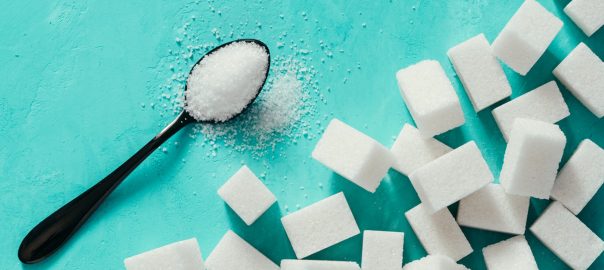
Cutting out Processed Sugar
The Top 5 Healthiest Ways to Remove Sugar from Your Diet
Learn how to effectively cut sugar from your diet based on science, plus find the best selection of sugar-free products to help you get there.
Chocolate, soda, muffins, cupcakes, doughnuts, cookies – why do these things taste so good? Because our brains love sugar and constantly crave more of it. So, it’s no wonder we get those midday energy crashes after we’ve eaten sugar-y cereal, pancakes and granola bars for breakfast and our sandwich on white bread for lunch. Plus, we may have drank a few too many cups of coffee with milk and sugar along the way.
The problem is, sugar is destructive to our bodies and it’s not the most efficient source of energy we can get from food. And, this is just 1 reason why so many people try to cut sugar from their diets – but often with limited success. We all wish we had more willpower to quit sugar, but the cravings always strike back! This is because sugar is a physical addiction that is difficult to break. What’s more, is the food industry thrives on getting us hooked on sugar in order to guarantee sales of their products.
This is why quitting sugar is not all about willpower – it’s actually about biochemistry. Don’t worry if you’ve struggled to cut sugar from your diet, you may have been going about it the wrong way. Understanding how our bodies react to sugar is the first step to quitting successfully, which is what we dive into with this article.
The Low Carb Grocery carries the best selection of sugar-free products in Canada! And, that can help you cut down on sugar-y foods, without having to sacrifice your favourite snacks.
Disclaimer: The information in this article is not medical advice. A low carb diet may not be suitable for you. Consult your health care provider before making any changes to your lifestyle or use at your own risk.
Sugar and the Brain
The way we learn anything in this world is based on our brain’s reward systems. If a positive outcome is the result of a certain behaviour, our brains learn to do more of that behaviour. On the other hand, if the outcome is a negative response, then our brains avoid this behaviour in the future. Think back to when you were a kid – maybe your parents rewarded you with ice cream if you got a good grade, cleaned your room or did something nice. Since childhood, many of us have come to associate sweet things with doing something good. This psychological response may be the reason many of us look to sugar when we are feeling stressed, sad or bored.
When we eat sugar, our brain’s reward system is also activated on a chemical level. Sugar causes the release of dopamine in the reward centre of the brain. Dopamine plays a big role in motor control, motivation and reinforcement – which can literally have us impulsively reaching for another candy bar. Dopamine produces feelings of pleasure and satisfaction that are hard to ignore, and these feelings provide us with the motivation to keep repeating the behaviours that produced the dopamine response.
Dopamine is responsible for addictions – and pretty much anything can become addictive if it activates our brain’s reward centres. But special attention should be paid to substances which naturally produce dopamine in our brains, such as sugar and other drugs. When someone takes highly addictive drugs, a lot of dopamine is released in the brain due to the effects of the drugs. When too much dopamine is released, the brain experiences a rush of euphoric sensations, followed by an unpleasant crash that can last for hours or days. This also raises the brain’s threshold for dopamine, and consequently, it requires more of the substance next time in order to achieve the same level of pleasure and satisfaction. It even causes the production of dopamine in anticipation of these feelings of pleasure. This can cause our attention to be drawn to sweets even when we are not hungry, resulting in cravings. Daily habits also play a big role in the activation of the dopamine system; if we normally have a chocolate bar or soda in the afternoon, our brain will get used to this timed-release of dopamine and crave these foods at the same time every day.
Sugar and the Body
On a cellular level, excess sugar in the blood causes our veins and arteries to become inflamed, grow thicker and stiff. This puts stress on your heart and causes serious damage over time, leading to heart failure, heart attacks and strokes. Unsurprisingly, heart disease is the number one leading cause of death in America – and we know the standard American diet is loaded with sugar.
Consuming excess sugar can also lead us very quickly down the path to obesity. When we eat sugar, insulin is produced which instructs our body to convert food energy (glucose) into fat and also prevents stored fat from being broken down. With reduced insulin sensitivity, blood sugar and insulin levels can go up significantly – meaning more fat storage in the body. In addition, sugar is not satiating, so it can easily cause us to overeat and gain weight. Obesity poses a wide range of health complications from joint pain to asthma, dementia, infertility, cancer and, again, heart disease. But don’t worry, we’re getting to some awesome alternatives soon!
Here are some other physical consequences of eating too much sugar:
- Tooth decay
- Decreased immunity
- Depression
- Acne
- Allergies
- Digestive problems
- Improper metabolic function
- Impaired memory and learning (especially in childhood)
- Higher cholesterol
- Faster aging
- Retina decay and cataracts
- Bone decay
- Oestrogen production in men (over-development of breast tissue)
- Erectile dysfunction
- Kidney disease
Sugar and the Food Industry
Sugar is good for food producers for two reasons: it’s very inexpensive and, as we mentioned, it’s highly addictive. Adding it to foods is a cost-effective way to achieve great taste and more sales. That’s why you can find it in just about anything – bread, sauces and condiments, soups, processed meats, cheeses, yogurt, cereals, snacks and of course, desserts.
While we aren’t overtly encouraged to eat a lot of sugar, we are still fed advertisements for products containing sugar on a daily basis. These products also come with friendly price tags, that are especially entrapping to those in less accessible or more vulnerable situations (i.e. low income, rural or remote locations).
Even for consumers who are actively trying to cut down on sugar, there are many ways the food industry “hides” sugar. Sugar can go by many names, which can be hard to identify on food labels. Some of these include:
- Glucose
- Fructose
- Sucrose
- Dextrose
- Dextran or malt powder
- Sucralose
- Barley malt
- Malt syrup
- Fruit juice concentrate
- Invert sugar
- Maltodextrin
- Maltose
- Evaporated cane juice
- High-fructose corn syrup
- Oat syrup
- Rice bran syrup
- Rice syrup
- Carob syrup
- Golden syrup
A lot of consumers have become aware of how to properly read food labels; they know that the ingredients are listed in descending order of the amounts used in the product, the first items on the list being the main ingredients. See our article “How To Understand Canadian Nutrition Labels” to get our full scoop on this information!
However, food manufacturers have also become aware of this increased consumer knowledge and subsequently, have begun using new tactics to hide sugar in their products. One of these tactics is using many different types of sugar in varying amounts to camouflage it amongst the other ingredients. When consumers see these other forms of sugar listed further down the ingredients list, they may assume the product is low sugar. But, cumulatively, there could still be a lot of sugar in these products. Protein bars are one of the foods to be especially careful with when reading the ingredients list.
Food manufacturers may also make other health claims about their products that distract consumers from the sugar content. The most common examples of these include “natural”, “organic”, “low-fat”, or diet/light versions of original products. Try to ignore these sneaky marketing claims and review the nutrition facts and ingredients list before making a blind purchase. In addition, look for the use of “healthy” or unrefined sugars. These might include agave nectar, honey, raw/organic cane sugar, birch syrup, coconut sugar, beet syrup and maple syrup. While these might be natural sources of sugar, they are still high-glycemic and constitute as added sugars. If you are trying to cut sugar from your diet, your best bet is to buy whole foods and minimally processed products, and always read food labels.
How to Cut Sugar Effectively
A sugar detox has many health benefits, although it may be difficult to withstand the side effects of removing sugar from the diet at first. Since frequent sugar consumption can constitute an addiction, expect there to be withdrawal symptoms. These symptoms can be different for each person, depending on how much sugar the body was used to consuming. Some of the physical and mental side effects of cutting sugar include:
- Light-headedness, dizziness or headaches
- Nausea
- Tingling sensations
- Fatigue
- Low mood/depression
- Anxiety (nervousness, restlessness, irritability, feeling on edge)
- Changes in sleep patterns (finding it harder to fall or stay asleep)
- Difficulty concentrating or focusing on tasks
- Sugar and carbohydrate cravings (including bread, pasta, chips, etc.)
While it may feel terrible to experience some of these symptoms, they should be short-lived. According to trial studies, most people can break a sugar addiction within 10 days. Once you cut, sugar, you will notice that you no longer crave or desire sweet things, since the brain is not dependent upon it anymore. Below are some tips to help prevent or limit the side effects of a sugar detox to get you on your way to success:
- Quit Sugar Gradually
Although eliminating sugar from the diet may cause unpleasant symptoms to persist for longer, they should be less intense. If you prefer, you can quit cold turkey, but be prepared for more severe side effects. The good thing about quitting sugar all at once is that your body will become accustomed to living without it much faster and your diet or weight loss progress can begin immediately.
Be sure to have a plan if you choose to quit sugar gradually, and don’t use this gradual elimination technique as an excuse to continue consuming sugar for a prolonged period of time. We suggest figuring out how many grams of sugar you normally consume in a day (there are several apps and online tools to help calculate how much sugar is in the foods you eat) and gradually decreasing that by a certain amount (ex. 10-20g/day each week). You can also choose to eliminate certain foods from your diet one or two at a time (ex. no candy one week, no ice cream the next, no chips the week after, etc.). Remember that things like white bread, pasta, rice and other high-glycemic carbohydrates can also contribute to sugar addictions, so eliminate these foods as well.
- Keep Yourself Full
To prevent snacking on sugar-y foods, try eating foods that will keep you more full after mealtimes. These include foods high in fibre and protein. Fibre and protein are digested more slowly by the body, so they keep us full longer. In addition, fibre can help stabilize blood sugar levels so we don’t experience energy crashes that can only be relieved by consuming more sugar. Stabilizing your blood sugar levels can also prevent the physical side effects of a sugar detox, including headaches and nausea. Try adding these following foods to your meals:
- Broccoli, cauliflower, Brussels sprouts and other cruciferous vegetables
- Leafy greens
- Artichokes
- Asparagus
- Mushrooms
- Legumes (beans, hummus, lentils, etc.)
- Nuts and seeds
- Fish
- Poultry
- Eggs
- Tofu
Including fibre and protein at breakfast is especially important, as the first meal of the day dictates a lot of how we feel and what we crave over the next several hours. Having a high fibre, high protein breakfast can help fight off sugar cravings, keep you satiated and elevate your mood and energy levels. Here are some healthy breakfast ideas:
- Omelette with mushrooms, spinach, bell peppers and feta cheese
- Green smoothie with almond milk, frozen cauliflower or zucchini, spinach, avocado, nut butter (or powdered protein) and a small handful of berries
- Low carb bread topped with avocado, cottage cheese or nut butter
- Oatmeal topped with sliced pears, nuts, chia seeds, hemp seeds and/or flax seeds
- Low carb granola topped with berries, cherries or dried apricots
- Drink More Water
Often, we confuse feelings of hunger or sweet cravings for simply being dehydrated. When sugar cravings strike, try to drink some water, wait 10-20 minutes, and see if you still feel hungry. You can also add things like cucumbers, berries and citrus juice to your water for a light and satisfying flavour.
Staying hydrated also helps us feel better in general and can combat some of those unpleasant side effects such as headaches and nausea. It is also important to increase your water intake when you include more fibre in your diet to prevent constipation or digestive problems.
- Manage Stress
Stress and emotions can impact our food cravings, and many studies have shown that sweet foods can have a calming effect on stress hormones. Before you make any major diet or lifestyle changes, it is extremely important to make sure your mental health and stress levels are managed properly. However, sometimes our diet can also have a reverse positive effect on our moods; so, improving your lifestyle could also help alleviate some of the emotional stress we endure when we do not take care of ourselves properly. Either way, stress and lifestyle go hand-in-hand.
Some ways to combat stress include talking to a friend, family member or trusted support person, doing something you enjoy every day or taking a walk in nature. Exercise, especially, has proven to be beneficial for relieving stress because of the mood-lifting hormones that are released when we sweat and move our bodies. If you constantly feel stressed, exercising may be the last thing on your mind, but try to get yourself to do some kind of physical activity at least a few times a week – whether it be a light walk, yoga, stretching or hitting the gym.
- Swap Out Your Old Products
Finally, it can help to find healthy replacements for foods you once loved so you don’t feel like your options are limited when you cut out sugar. Feeling deprived can lead to more intense cravings and can even cause complete regression.
Below, we put together a list of our favourite sugar-free products to buy, which can make the transition to a sugar-free diet easier:
- Natural Sweeteners
- Dark Chocolate
- Keto-Friendly (Low/No Sugar) Baked Goods
- Sugar-Free Beverages
- Low Carb Crackers and Chips
- Low Carb Pancake & Waffle Mixes à Find the best one for you in our “Healthy, Tasty Pancake and Waffle Mixes” article!
- Low Carb Pastas
- Low Carb Bake Mixes
- Sugar-Free Candies
Stay Connected
We hope that this article helps you in achieving your goals to cut or reduce sugar in your diet. Make sure to check out our top brands for sugar alternatives:
We’d also love if you could share your thoughts through a Google Review, Facebook and Instagram pages! Please also consider subscribing to our Weekly Newsletters for updates on the latest products and getting first access to weekly sales!






